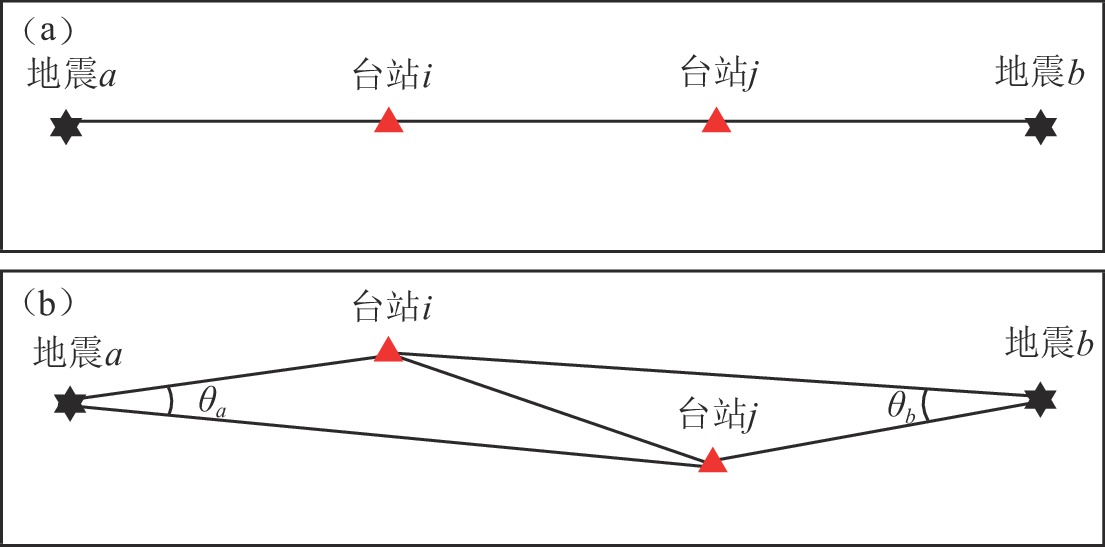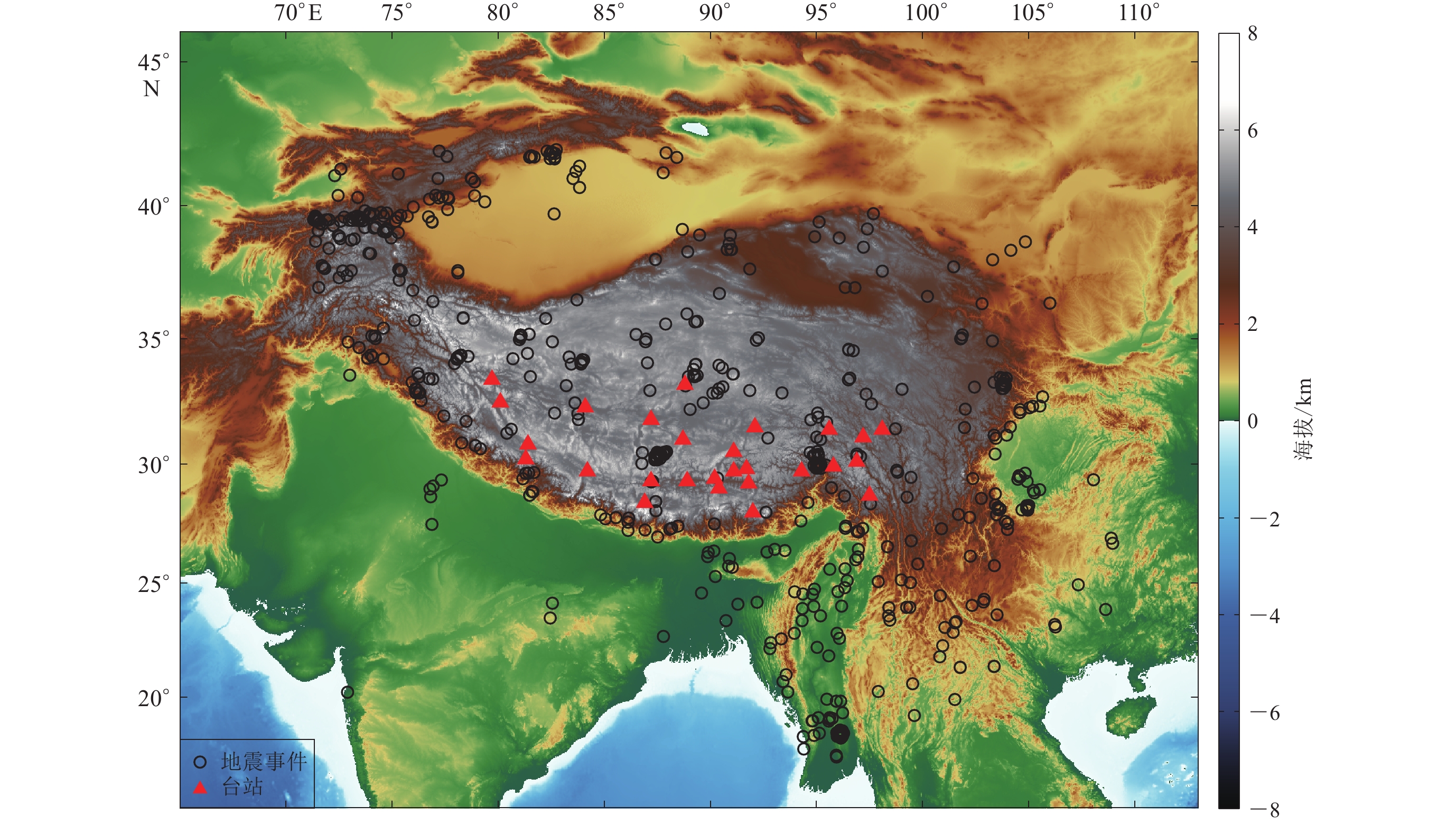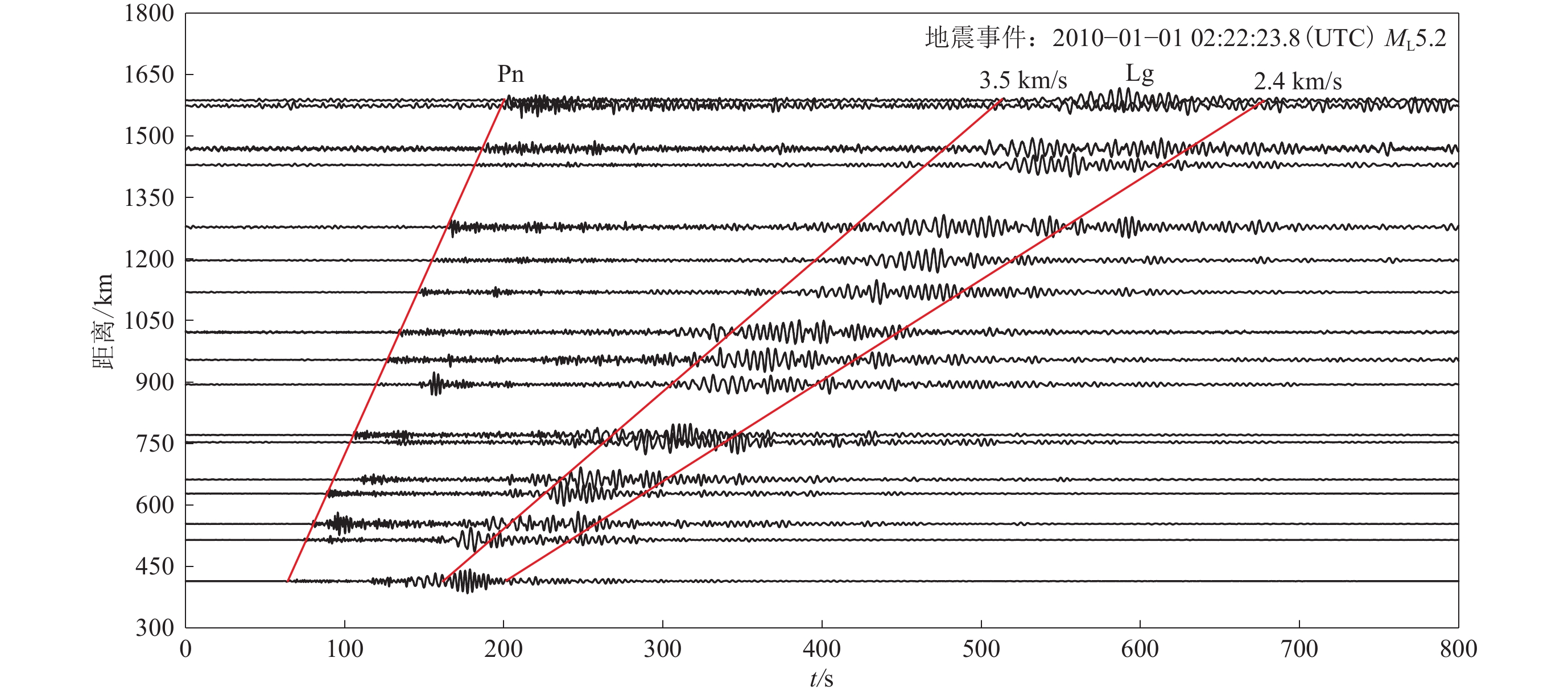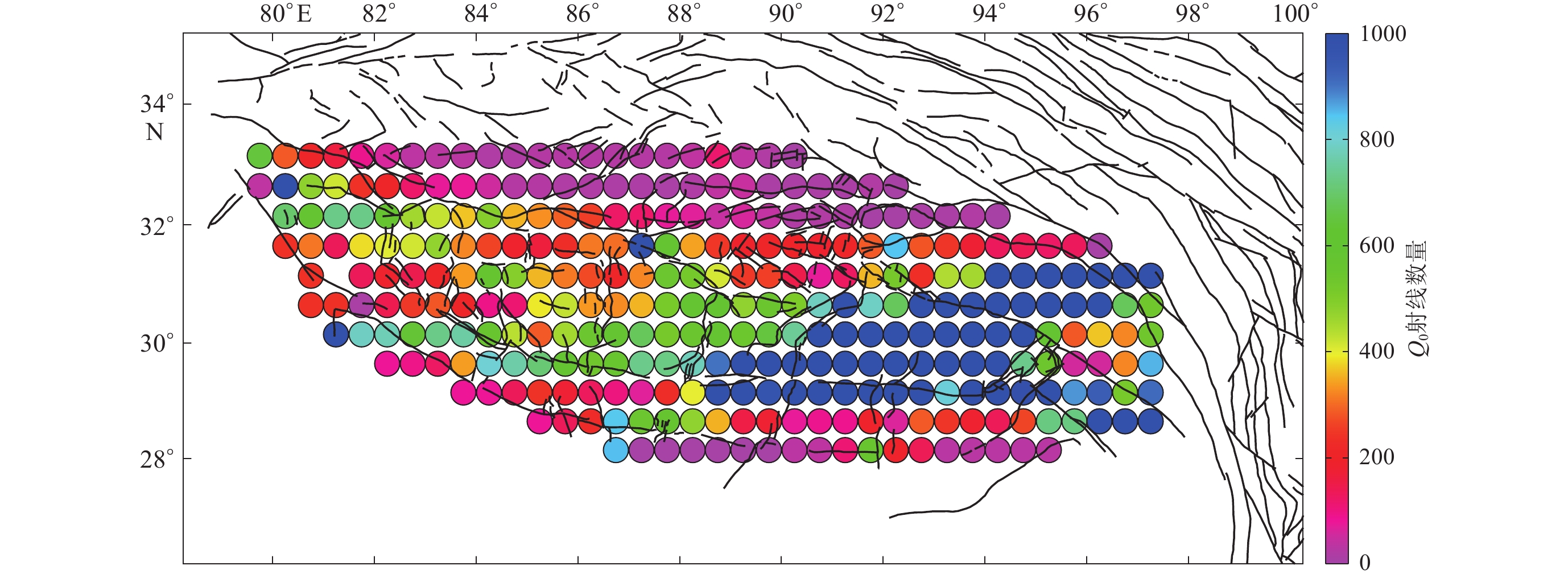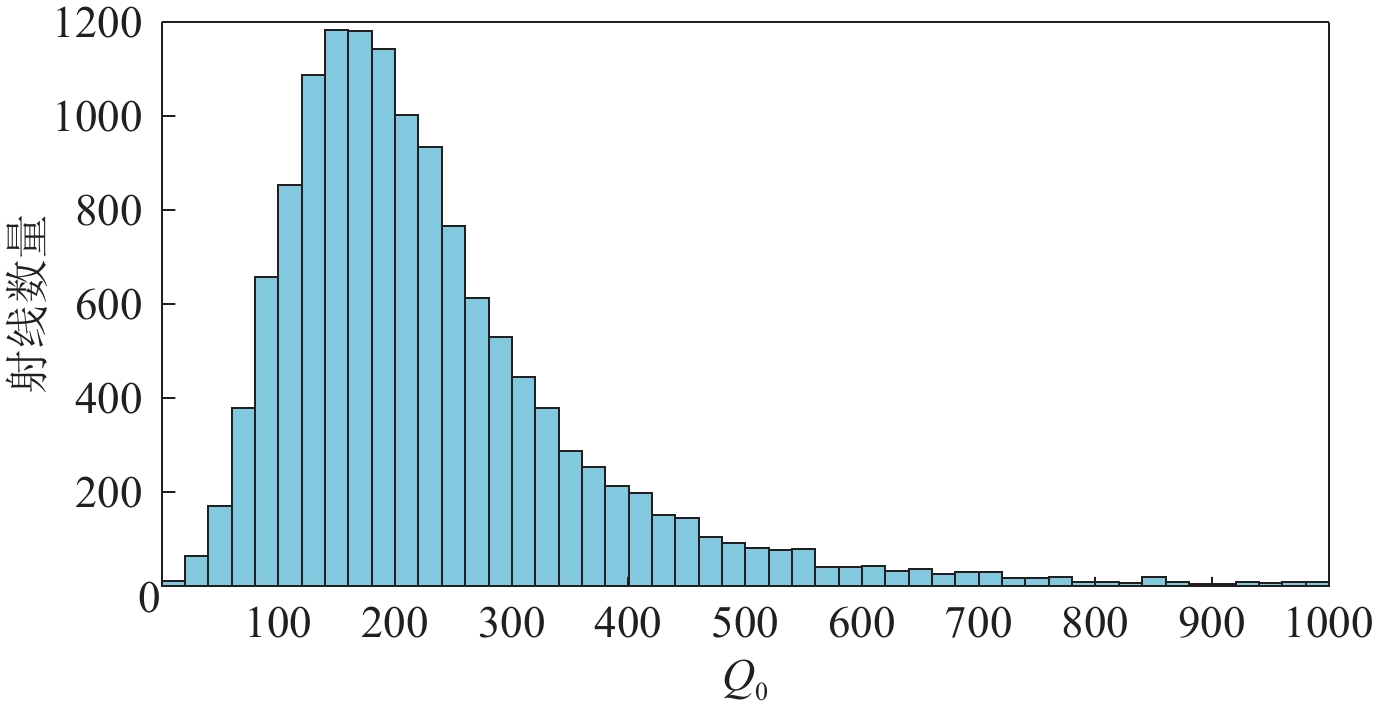Crustal attenuation in the southern Tibetan Plateau by reverse two-station Lg-wave Q value tomography
-
摘要: 首次基于2017—2019年西藏自治区区域台网27个宽频带固定台站记录的757次地震的波形资料,利用反双台法开展了青藏高原南部地区1 Hz的Lg波Q值层析成像研究。研究中采用3.5—2.4 km/s的速度窗截取了1 981条Lg波,计算得到13 543条路径上的Q值,测试了1°×1°和0.5°×0.5°网格下的棋盘格恢复情况,得到了0.5°×0.5°分辨率的Lg波Q0值层析成像。反演结果显示:青藏高原南部地壳整体的Lg波呈高衰减、低Q值,与P波速度负异常、地热分布及东部的两条裂谷系对应良好,因此推断青藏高原南部地壳存在广泛的熔融物质;两条可能存在的流体-熔融物质通道中,主通道位于亚东—谷露裂谷与桑日—错那裂谷之间,副通道沿雅鲁藏布江缝合带分流而出。此外,还对亚东—谷露裂谷两侧熔融物质的分布差异予以分析,结果表明,印度板块与欧亚板块碰撞前端存在不同的动力学演化模式,亚东—谷露裂谷以西符合缩短增厚理论,以东符合“水泵”模式。Abstract: Based on the seismic waveform data of 757 earthquakes recorded by 27 broadband stations of Tibet Autonomous Region seismic network from 2017 to 2019, it is for the first time that the reverse two-station method has been applied to 1 Hz Lg-wave Q value tomography study in the southern Tibetan Plateau. In this research, total 1 981 Lg-waves were intercepted from the velocity window of 3.5−2.4 km/s and the Q values of 13 543 paths were calculated. After testing the checkerboard recovery of 1°×1° and 0.5°×0.5° grids respectively, we got the tomography of the Lg-wave Q0 value of the southern Tibetan Plateau with 0.5°×0.5° resolution. The inversion result shows that there exhibits high attenuation and low Q values of Lg-wave in the southern Tibetan Plateau crust, which is highly consistent with the negative anomaly of P-wave velocity, the geothermal distribution and two rift valleys in the east of the Tibet. Therefore it is inferred that there may be widespread molten material in the crust of the southern Tibetan Plateau and two fluid-melting channels. The main channel is located between the Yadong-Gulu rift and the Sangri-Cona rift, and the secondary channel flows out along the Yarlung Zangbo suture zone. By analyzing the differences of molten material distribution on both sides of the Yadong-Gulu rift, it is considered that there are different dynamical evolution models in the front-end of collision between Indian Plate and Eurasian Plate, the dynamical evolution to the west of Yadong-Gulu rift is in accordance with the theory of shortening and thickening, and that to the east of Yadong-Gulu rift is consistent with the “pump” mode.
-
Keywords:
- Tibetan Plateau /
- Lg wave attenuation (QLg) /
- reverse two-station method /
- tomography
-
引言
青藏高原南部作为印度板块与欧亚板块碰撞的前端,其地质构造和动力学演化长期以来一直是研究的热点与难点。自印度板块于雅鲁藏布江缝合带俯冲至欧亚板块下方开始,强烈的挤压使碰撞前沿的青藏高原南端地壳产生大范围的缩短和增厚,高原迅速隆升,并伴随着活跃的火山与岩浆运动,以及频发的天然地震和密集的地热活动(白嘉启等,2006)。因此,青藏高原地壳结构与断层运动、地震活动以及地表高热流、高水热活动均紧密相关,研究该地区的地壳结构对确定青藏高原南部的构造背景及动力学过程具有重要意义。
近年来研究人员通过多种地球物理方法对青藏高原南部地壳进行了探究(Hu et al,2000;张衡等,2011),并且实地开展了一系列大型项目,例如1980年中法合作的“喜马拉雅地质构造与地壳上地幔的形成演化”项目、1986年的“亚东—格尔木岩石圈地学断面综合研究”项目以及1992年中美两国牵头执行的“青藏高原和喜马拉雅深部剖面综合研究”(International Deep Profiling of Tibet and the Himalayas,缩写为INDEPTH)项目(赵文津等,2008)。INDEPTH项目通过综合深地震反射、广角反射、宽频大地电磁和重力等多种手段,获得了青藏高原南部的地壳厚度、速度结构、电性特征、局部存在流体和熔融层等大量重要信息,对其复杂的活动构造演化有了新的发现(冯昭贤,赵文津,1997)。此外,张衡等(2011)得到了青藏高原东南部的P波速度结构模型,其中40 km和70 km深度的低速异常达到2%,将地壳低速异常区的产生解释为印度板块俯冲过程中地幔高温物质的倾斜上涌。参考中国大陆地区的热流分布图,中国大陆热流平均值为(63±24.2) mW/m2,而高热流值区域集中于青藏高原南部,普遍高于100 mW/m2,最高可达319 mW/m2 (Hu et al,2000)。地壳内存在高温熔融物质与流体是导致地震波衰减的一个关键因素,因此通过研究地震波衰减的横向不均匀性也可以有效地促进青藏高原的地壳动力学研究。
地震波的衰减强弱用介质的品质因子Q值来描述,也称作衰减因子或耗散因子,低Q值表示强衰减,高Q值表示弱衰减。地震波的衰减一般由传播介质岩石的成分、裂纹及其均匀程度、温度、孔隙流体以及断裂带和板块构造影响引起,所以通常构造稳定地区的地震波衰减较弱,具有高Q值,而地壳内存在诸如岩性变化、裂隙含流体、高温异常、部分熔融等构造活动的地区,其地震波衰减较强,具有低Q值(周连庆等,2008b)。
在目前相关研究中,地震学研究人员分别采用面波、体波、尾波、Lg波、Sn波和Pg波等震相讨论了不同地区对地震波的衰减(Herrmann,1980;Myers et al,1998;Gök et al,2003;Bao et al,2011b;何静等,2017)。在大陆近震震相中,Lg波相比于其它震相的强度和能量更高,振幅最为突出,是最容易识别的震相,且Lg波作为地壳内导波,其能量集中在地壳内,可在大陆地壳内长距离传播,振幅对地壳构造和性质非常敏感(Campillo et al,1985)。
利用天然地震研究Lg波Q值横向分布的计算方法,按照所使用台站和事件的数量和分布可大致分为三种:单台法、双台法和反双台法或反双事件法。反双台法相比于其它Q值计算方法,能有效地去除震源、仪器响应和场地响应的影响,虽然该方法对于台站和事件的分布条件比较苛刻,但是其结果较为准确,是计算Lg波Q值方法中结果最稳定、精度最高的一种方法(Ford et al,2008;何静等,2017)。本文研究的青藏高原南部地壳的地质构造复杂,地震波信噪比较低,衰减较强,因此,降低Q值计算过程中产生的误差对青藏高原南部的地震波衰减研究尤为重要。
青藏高原南部Lg波衰减研究较早的是McNamara等(1996)对Lg波在青藏高原的传播特性研究,该研究拟合出高原内部Lg波的衰减参数Q0为366±37,依赖性指数η为0.45±0.06,并且指出Lg波在该高原区域的最大传播距离为700 km,这种Lg波传播的低效现象被称作Lg波阻塞,在青藏高原北部和南部的边界处均已被揭示(Ruzaikin et al,1977;Ni,Barazangi,1983),但这个Lg波的传播距离,比同样低Q值的伊朗(Q0≈200)的Lg波传播距离1 400 km (Nuttli,1980),以及美国西部(Q0<200)约2 000 km (Xie,Mitchell,1990a;Xie,1998)的Lg波传播距离小了很多。Xie (2002)基于相同的实验数据,利用双台法重新计算了该地区的Q0值,得到0.2—3.6 Hz内Q0=126±9,η=0.37±0.02,并定性地支持了McNamara等(1996)指出的Lg波在此区域的传播距离,但定量上拟合出的Q0平均值却较McNamara等(1996)低了许多。Reese等(1999)和Phillips等(2000)估算了青藏高原的Lg波Q0值,得到该值一般在200以上。Fan和Lay (2002,2003)给出了青藏高原三个分区的Lg波衰减平均值,总体Q0在141—224之间。Bao等(2011a)使用反双台法计算了青藏高原东部及邻近地区的Lg波和Pg波的Q值,并生成了分辨率为1°×1°的Q值层析成像。Singh等(2012)使用双台法研究了喜马拉雅—青藏大陆岩石层造山(Himalayan-Tibetan Continental Lithosphere During Mountain Building,缩写为Hi-CLIMB)项目研究区域(西藏西侧南北向条带状区域)的Lg波衰减,其结果显示Q0值在88—165之间。Zhao等(2013a)结合单台法和双台法反演了青藏高原及周边地区0.5 Hz,1 Hz和2 Hz的Lg波Q值成像,其结果表明青藏高原地壳可能存在两条熔融物质的流动通道,主通道从高原北端向东、东南方向延伸,在刚性的四川盆地阻隔下,又向南转向。
上述可见前人的研究结果并不一致,这可能是由于所使用的研究方法不同、反演方法误差较大,也可能是由于研究区域较大而导致结果不稳定,并且高原地区地震波信噪比普遍较低,这也是产生误差的因素;其次,青藏高原南部地壳Lg波衰减的现有研究较少,且大部分研究是在区域范围计算平均值,而分析青藏高原的动力学演化需要更高分辨率的衰减模型。为进一步探究青藏高原南部的地壳动力学演化过程,弥补以上方法所导致的不足,本文拟采用稳定的反双台法分析青藏高原南部地区Lg波Q值的横向变化,首次基于2017—2019年西藏自治区区域台网记录的地震资料,从数据处理到计算Q值均进行高精度筛选,得到0.5°×0.5°高分辨率的Lg波Q值层析成像,并结合青藏高原南部的活动构造背景分析该地区Lg波的衰减特性及其所包含的动力学意义,以期为青藏高原南部的动力学模型提供证据支持。
1. 研究区构造背景
青藏高原是世界范围内发生陆内地震的主要区域,至今仍处于持续活跃的构造活动当中,该地区发生的地震不仅震级大、频率高、地震活动分布规律强,且多为浅源性地震,震中位于活动构造带上,高原周围多为逆冲运动,高原内分布着拉张性的地震事件(艾印双,郑天愉,1997;李娱兰,2019)。
青藏高原是中生代之后经印度洋拉张、冈瓦纳(Gondwana)古陆分化向北、印度板块与欧亚板块在运动过程中发生数次碰撞而形成,因此普遍认为青藏高原是由多地体拼合而成,其中本文针对青藏高原南部的研究区域被三条缝合带划分成三个地体(图1中蓝色方块区域)。三条缝合带由北向南依次为金沙江缝合带、班公湖—怒江缝合带和雅鲁藏布江缝合带,所划分成的三个地体为羌塘地体、拉萨地体和喜马拉雅地体,其中包括我国温泉数目最多、延展最长的喜马拉雅地热带,且由于构造活动的持续挤压,南部地体不断隆升,形成南厚北薄的地壳(张红亮,2010)。若这些东西向分布的缝合带是古特提斯构造域演变的印迹,那么近南北向延伸的多条大型构造则是青藏高原南部构造特征的代表,被称作“正断层体系”或“藏南裂谷系”。作为欧亚大陆碰撞的前端,变形强烈,周围地震频发(才巴央增,赵俊猛,2018)。藏南裂谷系是青藏高原南部地壳结构形变由近南北向的压缩转变为近东西向的拉张之后所产生,大体位于喜马拉雅山前逆冲断裂带和北部斜列蔓延的喀喇昆仑—嘉黎走滑断裂带中,大约形成于距今8—23 Ma前,由正断层围限的地堑和半地堑构造组成(Tapponnier et al,1981;Armijo et al,1989)。吴中海等(2015)统计青藏高原的天然地震强度和活跃性的结果显示,藏南裂谷系的天然地震相对于藏北南北向正断层的地震更加活跃。
西藏自治区地处地中海—喜马拉雅地热带的中东部,是我国地热活动最强烈的地区,我国绝大部分高温地热资源富集于此。青藏高原热流值南高北低,西藏自治区共有664个水热监测点,其中藏南、藏中和藏东有575个,同时拥有数量众多的温泉。也正是这些丰富的地热活动,使得西藏地区的地壳衰减尤为强烈。以班公湖—怒江缝合带为界,南部地体的热流值高达61—319 mW/m2,高温地热活动集中分布于雅鲁藏布江缝合带与其南北两侧(白嘉启等,2006)。
作为研究大陆碰撞动力学的绝佳场地,青藏高原隆升动力学的演化模式长期以来一直是多种学说的争论焦点,如England和Houseman (1988)提出的增厚缩短理论,Zhao和Morgan (1987)提出的“水泵”模式,Tapponnier等(1982,2001)提出的走滑逃逸学说等(李永华,吴庆举,2007;李仕虎等,2012)。印度—欧亚的陆-陆碰撞过程究竟是哪一种演化模式,亦或是由多种模式共同作用而产生现今的青藏高原,尚需更多的证据为此提供约束。
2. Q值计算方法
介质的品质因数Q值定义为
$$ \frac{1}{Q} {\text{=}} \frac{1}{{2\pi }}\frac{{\Delta E}}{E}{\text{,}} $$ (1) 式中,1/Q代表损耗因子,E代表地震波初始能量,ΔE代表地震波一个周期的能量损耗(周蕙兰,1990)。Q值为频率相关函数,定义为
$$ Q{\text{(}}f {\text{)}} {\text{=}} {Q_0}{f^\eta }{\text{,}} $$ (2) 式中:Q0为频率f=1 Hz时,即1 Hz处的Q值(Mitchell,1980);η为依赖性指数,反映了Q值与f的依赖关系。一般情况下,传播介质的固有吸收衰减与频率的相关程度偏弱时,η较小;散射衰减与频率的相关程度偏强时,η较大(何静等,2017)。根据Sato (1967)计算频率域的体波振幅理论公式,推导出同为频率域的近震波形Q值的振幅表达式为
$$ A{\text{(}}{f{\text{,}}\varDelta } {\text{)}} {\text{=}} S{\text{(}}f {\text{)}}R{\text{(}}\theta {\text{)}}I{\text{(}}f {\text{)}}E{\text{(}}f {\text{)}}G{\text{(}}\varDelta {\text{)}}\exp \left[ { {\text{-}} \frac{{\pi f\varDelta }}{{vQ{\text{(}}f {\text{)}}}}} \right]{\text{,}} $$ (3) 并将其应用于双台法中,台站i记录到的地震事件a在频率域的振幅可表示为
$$ {A_{ai}} {\text{=}} {S_a}{\text{(}}{f{\text{,}}\theta } {\text{)}}{I_i}{\text{(}}f {\text{)}}{E_i}{\text{(}}f {\text{)}}{G_{ai}}{\text{(}}\varDelta {\text{)}}\exp \left[ { {\text{-}} \frac{{\pi f{\varDelta _{ai}}}}{{vQ{\text{(}}f {\text{)}}}}} \right]{\text{,}} $$ (4) 式中:A为频率域振幅;Sa(f,θ)为震源函数,涵盖了震源辐射效应,即S( f )R(θ)项;I为仪器响应,E为场地效应,Δ为震中距,v为Lg波群速度;G为几何扩散参数,G(Δ)=G0Δ−m,G0为常数,m为几何扩散指数,在频率域下普遍取为0.5 (Shin,Herrmann,1987;Yang,2002)。根据式(4),同一事件a被较近台站i与较远台站j记录到的Lg波振幅谱之比为
$$ \frac{{{A_{ai}}}}{{{A_{aj}}}} {\text{=}} \frac{{{I_i}}}{{{I_j}}}\frac{{{E_i}}}{{{E_j}}}\frac{{\varDelta _{ai}^{ {\text{-}} m}}}{{\varDelta _{aj}^{ {\text{-}} m}}}\exp \left[ {\frac{{\pi f{\text{(}}{{\varDelta _{aj}} {\text{-}} {\varDelta _{ai}}} {\text{)}}}}{{vQ{\text{(}}f {\text{)}}}}} \right]{\text{,}} $$ (5) 式中Aai和Aaj分别为台站i和台站j接收到的事件a的频率域振幅。经过式(5)就可以有效地消除震源项S所带来的影响,双台法即根据式(5)继续计算两个台站i与j之间的Q值。
反双台法则是在式(5)的基础上,将两个台站i和j分别记录到的两个事件a和b的振幅谱比结合在一起。如图2所示,一组台站和事件震中处在同一个大圆弧上,且两个事件的震中处于两台站连线的反向延长线上,其中图2a为理想条件下的几何路径,图2b为实际条件下的几何路径,台站和事件处于同一个大圆弧的左右,偏离范围限制在15°之内,即θa和θb均小于15°。为保证Lg波发育良好,两事件间的距离和两台站间的距离,即Δab和Δij,应大于150 km (Bao et al,2011a)。在式(5)的基础上,振幅谱比Aai/Aaj和Abi/Abj结合后为
$$ \frac{{{A_{ai}}}}{{{A_{aj}}}}\frac{{{A_{bj}}}}{{{A_{bi}}}} {\text{=}} {\left({\frac{{{\varDelta _{ai}}}}{{{\varDelta _{aj}}}}\frac{{{\varDelta _{bj}}}}{{{\varDelta _{bi}}}}} \right)^{ {\text{-}} m}}\exp \left\{ { \frac{{\pi f\left[ {{\text{(}}{{\varDelta _{bi}} {\text{-}} {\varDelta _{bj}}}{\text{)}}{\text{-}}{\text{(}}{{\varDelta _{ai}} {\text{-}} {\varDelta _{aj}}} {\text{)}}} \right]}}{{vQ{\text{(}}f {\text{)}}}}} \right\}{\text{,}} $$ (6) 从而进一步抵消仪器响应和场地效应所产生的误差和影响,相比于双台法能够得到更准确的Q值,其中Δaj>Δai,Δbi>Δbj,将Q提出并结合式(1)即可得到
$$ \frac{1}{{Q{\text{(}}f {\text{)}}}} {\text{=}} \frac{v}{{\pi f\left[ {{\text{(}}{{\varDelta _{bi}} {\text{-}} {\varDelta _{bj}}} {\text{)}} {\text{-}} {\text{(}}{{\varDelta _{ai}} {\text{-}} {\varDelta _{aj}}} {\text{)}}} \right]}} \ln \left[ {\left({\frac{{{A_{ai}}}}{{{A_{aj}}}}\frac{{{A_{bj}}}}{{{A_{bi}}}}} \right){{\left({\frac{{{\varDelta _{ai}}}}{{{\varDelta _{aj}}}}\frac{{{\varDelta _{bj}}}}{{{\varDelta _{bi}}}}} \right)}^m}} \right] {\text{=}} \frac{1}{{{Q_0}{f^\eta }}} {\text{.}} $$ (7) 3. 数据及处理
本研究首次使用2017年5月至2019年5月西藏自治区区域台网27个宽频带固定台站记录的757次ML4.0—6.5地震事件(图3),地震目录取自美国地质调查局(United States Geological Survey,缩写为USGS);震中距为3°—10°,确保Lg波能够被完全记录到;震源深度为0—50 km (USGS,2019)。选择信噪比高的垂直向分量,使用RESP类型的仪器响应文件去仪器响应并滤波后,截取Lg波段。
确定Lg波群速度是一项极为重要的工作,由于不同地区的地壳厚度和地质构造不同,Lg波群速度会有差异。Press和Ewing (1952)最早定义Lg波,认为Lg波是一种涵盖高频率P波和S波的短周期地壳导波,群速度一般在3.5—3.0 km/s,频率主要集中在0.5—5 Hz。多数研究都采用相近的Lg波速度窗,例如:Zhao等(2010,2013b)在研究东北地区、华北克拉通地区和青藏高原地区时采用3.6—3.0 km/s的Lg波速度窗;周连庆等(2008a)在川滇地区研究中采用3.6—2.8 km/s。部分研究使用较宽的Lg波速度窗,例如:朱新运(2016)关于华北盆地的Lg波衰减计算采用3.65—2.6 km/s的速度窗;张锦玲等(2019)在研究宁夏地区Lg波衰减时采用3.6—2.2 km/s的速度窗。对于本文研究区域附近,Singh等(2012)在喜马拉雅—青藏大陆岩石造山带的Lg波Q值研究中采用3.6—2.8 km/s的速度窗;Xie等(2004)关于西藏地壳的Lg波Q值研究采用3.5—3.0 km/s的速度窗;Fan和Lay (2002)以及Zhao等(2013a)在关于青藏高原地区地壳中Lg波衰减的研究中均采用3.6—3.0 km/s的速度窗。
由于青藏高原南部地壳较厚,构造复杂,地震资料的信噪比不稳定,本文通过观察大量的波形发现使用短的Lg波速度窗并不能保证Lg波被完整截取,若速度窗过短,频谱的离散性会变大,数据不稳定,然而只有在波谱稳定的情况下,速度窗大小对Lg波Q值的影响才可以忽略(张锦玲等,2019)。因此,本文通过检测青藏高原南部区域Lg波的群速度窗口,确定利用3.5—2.4 km/s的速度窗来截取该地区的Lg波,这样可为反双台法计算Lg波Q值提供更准确的Lg波数据(图4)。
截取Lg波后,在Pn波前截取与Lg波等长的波段作为噪声。鉴于本文旨在于研究1 Hz处的Q值,即Q0,因此在0.5—1.5 Hz的频段内,选取间隔为0.05 Hz的21个参考频率点,计算这21个参考频率点的噪声和Lg波的傅里叶振幅谱,从中挑选出信噪比大于2的谱值,最后根据
$$ A_{{\rm{sig}}}^2{\text{(}}{{f_{{\rm{ref}}}}} {\text{)}} {\text{=}} A_{{\rm{obs}}}^2{\text{(}}{{f_{{\rm{ref}}}}} {\text{)}} {\text{-}} A_{{\rm{noi}}}^2{\text{(}}{{f_{{\rm{ref}}}}} {\text{)}} $$ (8) 去除噪声,获得Lg波的真振幅(Ringdal et al,1992)。以这种方式最终得到6 833条Lg波在1 Hz前后的21个参考频率点处的振幅。为了提高精度,将存在3个频率以上未计算出振幅的Lg波剔除,保留剩余的1 981条Lg波,将其振幅用于Q值计算。
4. Q值成像结果
利用台站和事件的经纬度信息,首先根据反双台法的几何路径匹配出符合条件的台站与事件组合;然后将0.5—1.5 Hz频率范围内的Lg波振幅进行非线性回归,计算得到1 Hz的台站与台站路径上的Q0值射线对;之后设置Q0<1 000,η≥0,剔除Q值误差高于Q值自身30%的Q0值;最终得到13 543条路径上的Q0值。由于反双台法计算的是两台站之间的Q值,所以台站连线覆盖区域即为研究区域,将研究区域用圆圈划分为0.5°×0.5°的网格,统计每个网格穿过的射线数量,结果如图5所示,可见,Q0射线在中心区域覆盖良好,射线的Q0平均值为232,峰值集中于120—200之间(图6)。
将每条射线穿过网格的长度及其Q0值填入研究区域网格内,通过棋盘格方法对1 Hz的Q值进行分辨率测试,以确定研究区合适的网格尺寸。网格的设定取决于波形的质量以及射线的分布等要素,即:网格设置得过大,难以展示出Q值的细节变化;网格设置得过小,若未被射线覆盖则会产生欠定问题(周连庆等,2008a)。使用最小平方QR分解(least squares QR decomposition,缩写为LSQR)法(Paige,Saunders,1982)反演的结果显示,1°×1°和0.5°×0.5°网格下的棋盘格检测板均恢复良好,除边缘台站未达到外,研究的核心区域具有较高的分辨率(图7)。因此绘制出0.5°×0.5°分辨率下Q0值的横向变化,得到Q0的成像结果,如图8所示。
由图8可见,青藏高原南部地区Lg波的Q0值大致分布于100—300区间,平均Q0值为249.2,其中拉萨地体的平均值为231.1。对比国际上典型的稳定地盾区的Lg波Q0值,如非洲西部地盾区为960,加拿大地盾区为1 100,西澳大利亚地盾区为700—1 200 (刘建华等,2004),本文的结果远低于上述Q0值。较为稳定的中国东北部(赵连锋等,2018)和美国东部(Herrmann,1980)的Q0最大值也超过800,可见青藏高原南部整体呈现强烈的低Q0值异常。对于构造活动区,如东非裂谷的Q0值约为360 (Xie,Mitchell,1990b),美国西部的Q0值在300以下(Herrmann,1980),伊朗的Q0值在200左右(Nuttli,1980),青藏高原南部的Q0值与上述构造活跃地区大致相同,衰减强烈,尤其是西藏中东部,Q值相对更低。从那曲到拉萨一直向南延伸至日喀则,再沿雅鲁藏布江缝合带附近向西,东侧至林芝附近区域,其Q值均低至100左右,对应于东部的桑日—错那裂谷和亚东—谷露裂谷的位置,且低Q值区域的延伸方向与两条裂谷的走向相近。此外,图7棋盘格检测板恢复良好,从侧面说明“青藏高原南部呈现高衰减”的结果可信。
5. 讨论
反双台法是目前计算Lg波衰减较为准确的方法,但现有研究对反双台法的应用还很少,本文尝试编制了一套反双台法计算程序,将其应用于青藏高原南部的Lg波衰减层析成像,以弥补该地区高分辨率Lg波Q值成像的空缺。此外,本文还重新定义了青藏高原的Lg波群速度,认为3.5—2.4 km/s是青藏高原地区更合适Lg波的速度窗口,突破了传统计算中采用3.6—3.0 km/s群速度窗的限制,这为本研究准确提取Lg波能量奠定了基础。
现有阶段利用Lg波对青藏高原南部Q值层析成像的研究较少,可参考的只有Zhao等(2013a)对青藏高原及周边大范围地区的层析成像,以及Bao等(2011a)对青藏高原东部及邻近地区的层析成像。Zhao等(2013a)利用单、双台法反演得到了青藏高原的Lg波Q值层析成像,本文结果与Zhao等(2013a)的青藏高原南部地区衰减趋势的相似度较高,且Q值大小也与其接近,其中:西藏中东部的那曲—拉萨—日喀则路径上的地震波衰减强烈,Q值较低,本文和Zhao等(2013a)给出的Q值均在150左右;西藏西部地震波衰减较弱,Q值偏高,本文和Zhao等(2013a)给出的Q值均在300左右。本文所采用的反双台法是基于单台法和双台法的改进,与Zhao等(2013a)衰减模型结果的一致性证明了本研究所使用反双台法的计算程序可靠。
Bao等(2011a)对青藏高原东部及邻近地区反演得到了分辨率为1°×1°的Lg波衰减成像,在共同研究的西藏东部区域上,本文所得结果与其Q值的横向变化趋势吻合。虽然变化趋势一致,但本文的Q0值分布区间与其有所差别:本研究在西藏东部的最低Q0值在100—200之间,与多数前人对青藏高原估计的平均Q值相符(Fan,Lay,2002,2003;Xie,2002;Zhao et al,2013a);Bao等(2011a)的最低Q值在200—250之间,Q值整体偏大。本文与Bao等(2011a)使用相同的反双台法和LSQR反演方法,考虑到反双台法的原理为计算两台站间路径上的Q值,以及反双台法对数据的利用率较低,本文认为:由于网格会被经过的每一条Q值射线所影响,且在数据量不足够大而研究区域较大的情况下,该影响会被放大,网格内的Q值会被其它区域拉低或拉高,因而偏离真实的Q值。本文研究区域集中且数据充足,Q值未被青藏高原外的高Q值所影响,且在射线的筛选过程中,忽略了Q值误差超出Q值自身30%的数据,而这其中绝大部分是400以上的高Q值,这是造成本文研究区Q值普遍低于Bao等(2011a)的原因。
由于地震波Q值对高温异常和部分熔融较为敏感,与对温度和物质成分都很敏感的地震波速度相互补充,所以利用Q值和波速可以有效地探测地下介质的物质组成和物理状态,对照张衡等(2011)和张戈铭等(2019)关于青藏高原南部P波速度结构的研究可知,本文结果中的高衰减区与P波速度的负异常区对应良好。在青藏高原南部地区,地表热流值较高,可能指示了地壳内的高温异常,但其规模和范围还需要作为地壳内导波的Lg波低Q值异常来约束,对照Hu等(2000)的地表热流分布图可见,本文结果中的高衰减区有着青藏高原乃至全国的最高热流值。本文所获青藏高原南部的Q值层析成像与地震波速度结构和热流值分布高度相关,也证明了本研究结果的可靠性。
自十九世纪八十年代以来,国际上开展了大陆岩石圈地震台阵研究计划(Program for Array Seismic Studies of the Continental Lithosphere,缩写为PASSCAL)和INDEPTH等项目,科学家们通过多种地球物理学手段致力于青藏高原南部印度—欧亚板块碰撞的动力学研究。INDEPTH-MT是其中重要的宽频大地电磁研究项目,位于本文高衰减区的两处电磁剖面MT-100和MT-200 (图9)显示,地下15—20 km深度的导电性异常高,处于3 000—20 000 S之间,高出大陆稳定地区一到二个量级,并与INDEPTH中深地震反射所揭示的地震亮点和地震低速带保持一致,而这些将原因共同指向地壳内存在的熔融物质(Brown et al,1996;Wei et al,2001)。Nelson等(1996)分析了MT-100和MT-200电磁剖面,推断熔融导电物质不仅存在于两处电磁剖面,还可能大规模地分布于青藏高原南部。本文的Q值层析成像为此提供了依据。参考美国西部(Singh,Herrmann,1983)、东非裂谷(Xie,Mitchell,1990b)和土耳其—伊朗高原(Al-Damegh et al,2004)等熔融或新生代火山地区的地震波衰减,Q值介于150—360之间,本文研究区的平均Lg波Q0值为249.2,整体的低Q值指示青藏高原南部地壳广泛存在着高温熔融物质。Li等(2003)进一步量化电磁测深剖面中高导电性所需要的熔融或流体量,认为熔融物质上需要覆盖一层几百米厚度的水性流体层才能达到INDEPTH-MT项目下方至少6 000 S的导电率。对于此流体-熔融层的流通区域分布,本文层析成像结果中MT-100和MT-200附近更低的Q值区域对此提供了约束,利用成像中的强衰减区结合P波速度负异常和高热流的横向分布(Hu et al,2000;张衡等,2011;张戈铭等,2019),本文推断青藏高原南部的地壳流体-熔融物质通道分布于亚东—谷露裂谷东侧,其中主通道位于亚东—谷露裂谷与桑日—错那裂谷之间占据拉萨地体和喜马拉雅地体,次通道由主通道分流出来沿雅鲁藏布江缝合带向西延伸(图9中红色实线区域)。
![]() 图 9 青藏高原南部熔融通道(红色实线区域)的推断示意图Ⅰ ,Ⅱ ,Ⅲ和Ⅳ代表四个由雅鲁藏布江缝合带和亚东—谷露裂谷划分的地块Figure 9. The inference of melting channels in the southern Tibetan PlateauThe area delineated by red solid lines denotes melting channels,and the symbols of Ⅰ ,Ⅱ ,Ⅲ and Ⅳ represent four blocks separated by the Yarlung Zangbo suture and Yadong-Gulu rift
图 9 青藏高原南部熔融通道(红色实线区域)的推断示意图Ⅰ ,Ⅱ ,Ⅲ和Ⅳ代表四个由雅鲁藏布江缝合带和亚东—谷露裂谷划分的地块Figure 9. The inference of melting channels in the southern Tibetan PlateauThe area delineated by red solid lines denotes melting channels,and the symbols of Ⅰ ,Ⅱ ,Ⅲ and Ⅳ represent four blocks separated by the Yarlung Zangbo suture and Yadong-Gulu rift流体或熔融物质的分布对研究动力学演化非常重要,流体会显著改变岩石的流变性,减弱岩石强度,提高其蠕变速率,上涌的熔融物质为断裂带的逆冲、滑移和地块的运动提供了动力。印度板块整体向北俯冲挤压欧亚板块,形成青藏高原的复杂地貌,但作为冲头的印度板块前端是否与欧亚板块在碰撞处发生着相同的动力学作用,本文认为并不然。在亚东—谷露裂谷的西侧熔融物质分布有限,但东侧却广泛分布,由亚东—谷露裂谷分隔的东西两侧地块很可能由不同的演化机制主导。喻成等(2014)关于GPS水平速度场的研究结果表明:由亚东—谷露裂谷和雅鲁藏布江缝合带分隔成而的四个地块中,地块Ⅱ和Ⅲ向东南逃离亚东—谷露裂谷的速率明显高于地块Ⅰ和Ⅳ的运动速率(图9)。这是由于广泛分布于亚东—谷露裂谷东侧的地下流体-熔融物质为其提供了动力,而西侧熔融物质较少,地块的运动也相对较慢。结合Zhao和Morgan (1987)针对印度板块“注入”西藏提出的“水泵”模型,本文认为在印度板块与欧亚板块的碰撞过程中,亚东—谷露裂谷东侧碰撞部分的形成,是由于印度板块贯入黏滞性低的欧亚板块南端地壳时,西藏下地壳体积膨胀,由于空间压强的减小,熔融物质被吸入,因此亚东—谷露裂谷以东部分的动力学演化用“水泵”模式解释更为合理。而亚东—谷露裂谷西侧的演化更倾向于缩短增厚学说,地块Ⅰ和Ⅱ向Ⅲ和Ⅳ俯冲时,由于挤压作用地块Ⅱ和Ⅲ伴随着强烈的热物质运动共同向东侧逃逸,而由亚东—谷露裂谷分隔的地块Ⅰ和Ⅳ地壳熔融物质分布较少,而且呈现右旋挤压特征,说明两地块相对稳定坚硬,挤压主要造成了两地块垂向的缩短与增厚,而地块Ⅰ与Ⅳ之间的条带状高衰减熔融物质也被认为是由东部熔融区沿雅鲁藏布江缝合带分流而来。亚东—谷露裂谷两侧动力学演化的差异也是裂谷最初形成并且现今以(6.6±2.2) mm/a的高速率持续拉张的原因(Chen et al,2004)。
0.5°×0.5°分辨率是目前青藏高原南部Lg波Q值成像最高的分辨率,这可提供关于地下结构的诸多新认识:青藏高原南部地壳存在着广泛的熔融物质,结合大地电磁测深推测两条流体-熔融物质的通道,主通道位于亚东—谷露裂谷与桑日—错那裂谷之间沿南北向伸展,次通道由主通道于雅鲁藏布江缝合带处向西分流而出。结合前文对几处地块运动速率的分析,印度板块俯冲欧亚板块前端的动力学演化可能需要多种模型解释,如亚东—谷露裂谷以西符合缩短增厚模式,亚东—谷露裂谷以东符合“水泵”模型。
理论上地壳Lg波的衰减成像应包括上、中和下地壳,但是青藏高原南部地壳巨厚,大部分地区地壳厚度大于60 km。考虑到高原构造本身的复杂性,若是震源深度较大会造成地震波形质量较差,本研究在波形数据处理中观察到,震源深度在40 km以上的地震波的信噪比低,部分无法分辨出Lg波震相,导致最终成像结果可能只是青藏高原南部中、上地壳的层析成像,但这也正好说明了青藏高原南部高温物质对地壳的影响已经上升至浅部,那么是否应该做到或如何实现较为特殊的青藏高原的全地壳衰减反演尚待完善。
6. 结论
本研究首次使用反双台法得到了青藏高原南部地区的Lg波Q值层析成像,利用西藏区域台网记录的地震垂向分量波形数据,采用3.5—2.4 km/s的速度窗口截取Lg波,匹配出满足反双台法的台站-事件对,计算台站与台站之间的Q值,最终以0.5°×0.5°分辨率进行Q值成像。成像结果与前人对青藏高原地壳普遍认可的高衰减、低Q值结果一致,并且由于所使用的计算方法误差更小,成像的分辨率更高,Lg波衰减在局部细节上变化清晰。本文得到的主要结果如下:
1) 层析成像结果显示,青藏高原南部Lg波衰减存在明显的横向不均匀性,与P波速度和热流值的横向分布均有较强的相关性。
2) 研究区主要的两条高衰减带被认为是地下流体-熔融物质存在的通道,主通道位于亚东—谷露裂谷与桑日—错那裂谷之间并向南延伸,副通道由主通道于雅鲁藏布江缝合带处向西分流而出。
3) 青藏高原南部动力学演化可能由多种模式相共存,亚东—谷露裂谷以西更符合缩短增厚模式,亚东—谷露裂谷以东倾向于“水泵”模式。
-
图 9 青藏高原南部熔融通道(红色实线区域)的推断示意图
Ⅰ ,Ⅱ ,Ⅲ和Ⅳ代表四个由雅鲁藏布江缝合带和亚东—谷露裂谷划分的地块
Figure 9. The inference of melting channels in the southern Tibetan Plateau
The area delineated by red solid lines denotes melting channels,and the symbols of Ⅰ ,Ⅱ ,Ⅲ and Ⅳ represent four blocks separated by the Yarlung Zangbo suture and Yadong-Gulu rift
-
艾印双,郑天愉. 1997. 青藏高原地震活动及其构造背景[J]. 地球物理学进展,12(2):30–40. Ai Y S,Zheng T Y. 1997. Seismic activity in Tibetan Plateau and its tectonic implication[J]. Progress in Geophysics,12(2):30–40 (in Chinese).
白嘉启,梅琳,杨美伶. 2006. 青藏高原地热资源与地壳热结构[J]. 地质力学学报,12(3):354–362. doi: 10.3969/j.issn.1006-6616.2006.03.010 Bai J Q,Mei L,Yang M L. 2006. Geothermal resource and crustal thermal structure of the Qinghai-Tibet Plateau[J]. Journal of Geomechanics,12(3):354–362 (in Chinese).
才巴央增,赵俊猛. 2018. 藏南裂谷系的研究综述[J]. 地震研究,41(1):14–21. doi: 10.3969/j.issn.1000-0666.2018.01.002 Caibayangzeng,Zhao J M. 2018. A summary of researches on southern Tibet rift system[J]. Journal of Seismological Research,41(1):14–21 (in Chinese).
冯昭贤,赵文津. 1997. INDEPTH与INDEPTH-MT项目简介[J]. 现代地质,11(3):363–365. Feng Z X,Zhao W J. 1997. Simple introduction to project INDEPTH and subproject NDEPTH-MT[J]. Geoscience,11(3):363–365 (in Chinese).
何静,吴庆举,李永华,雷建设. 2017. 天然地震Lg波衰减研究进展及其在中国大陆地区的应用[J]. 地球物理学进展,32(2):466–475. doi: 10.6038/pg20170204 He J,Wu Q J,Li Y H,Lei J S. 2017. Developments of earthquake Lg-wave attenuation study and its application in the continental China[J]. Progress in Geophysics,32(2):466–475 (in Chinese).
李仕虎,黄宝春,朱日祥. 2012. 青藏高原东南缘构造旋转的古地磁学证据[J]. 地球物理学报,55(1):76–94. doi: 10.6038/j.issn.0001-5733.2012.01.008 Li S H,Huang B C,Zhu R X. 2012. Paleomagnetic constraints on the tectonic rotation of the southeastern margin of the Tibetan Plateau[J]. Chinese Journal of Geophysics,55(1):76–94 (in Chinese). doi: 10.1002/cjg2.1702
李永华,吴庆举. 2007. 中国地学热点研究区几个地学问题的探讨[J]. 国际地震动态,(9):11–19. doi: 10.3969/j.issn.0253-4975.2007.09.003 Li Y H,Wu Q J. 2007. Study on some “Hot Spot” areas of geo-sciences in China[J]. Recent Developments in World Seismology,(9):11–19 (in Chinese).
李娱兰. 2019. 青藏高原地震活动性及冈底斯成矿带东段上地幔顶部Pn波速度结构[D]. 北京: 中国地震局地球物理研究所: 1–8. Li Y L. 2019. Seismicity of the Qinghai-Tibet Plateau and Velocity Structure of Pn Wave on the Top of the Upper Mantle in the Eastern Gangdise Metallogenic Belt[D]. Beijing: Institute of Geophysics, China Earthquake Administration: 1–8 (in Chinese).
刘建华,刘福田,阎晓蔚,胥颐,郝天珧. 2004. 华北地区Lg尾波衰减研究:Lg尾波Q0地震成像[J]. 地球物理学报,47(6):1044–1052. doi: 10.3321/j.issn:0001-5733.2004.06.017 Liu J H,Liu F T,Yan X W,Xu Y,Hao T Y. 2004. A study of Lg coda attenuation beneath North China:Seismic imaging Lg coda Q0[J]. Chinese Journal of Geophysics,47(6):1044–1052 (in Chinese).
吴中海,叶培盛,王成敏,张克旗,赵华,郑勇刚,尹金辉,李虎侯. 2015. 藏南安岗地堑的史前大地震遗迹、年龄及其地质意义[J]. 地球科学:中国地质大学学报,40(10):1621–1642. Wu Z H,Ye P S,Wang C M,Zhang K Q,Zhao H,Zheng Y G,Yin J H,Li H H. 2015. The relics,ages and significance of prehistoric large earthquakes in the Angang graben in south Tibet[J]. Earth Science:Journal of China University of Geosciences,40(10):1621–1642 (in Chinese). doi: 10.3799/dqkx.2015.147
喻成,乔学军,王伟,史永明. 2014. 亚东—谷露裂谷带与块体运动的特征[J]. 大气测量与地球动力学,34(2):36–40. Yu C,Qiao X J,Wang W,Shi Y M. 2014. Characteristics of crust deformation in Yadong-Gulu rift and its surrounding areas with GPS data[J]. Journal of Geodesy and Geodynamics,34(2):36–40 (in Chinese).
张戈铭,李细兵,郑晨,宋晓东. 2019. 青藏高原中东部地壳和上地幔顶部P波层析成像[J]. 地震学报,41(4):411–424. doi: 10.11939/jass.20190003 Zhang G M,Li X B,Zheng C,Song X D. 2019. Crustal and uppermost mantle velocity structure beneath the central eastern Tibetan Plateau from P-wave tomography[J]. Acta Seismologica Sinica,41(4):411–424 (in Chinese).
张衡,赵俊猛,徐强. 2011. 西藏东部地区层析成像及东南部裂谷成因讨论[J]. 科学通报,56(27):2328–2334. Zhang H,Zhao J M,Xu Q. 2011. Seismic P-wave tomography in eastern Tibet:Formation of the rifts[J]. Chinese Science Bulletin,56(23):2450–2455. doi: 10.1007/s11434-011-4577-x
张红亮. 2010. 藏北水热活动的地质背景研究[D]. 北京: 中国地质大学(北京): 13–17. Zhang H L. 2010. Study on the Geological Background of Hydrothermal Activities in North Tibet[D]. Beijing: China University of Geosciences (Beijing): 13–17 (in Chinese).
张锦玲,朱新运,马起杨. 2019. 宁夏地区Lg波衰减及场地响应特征[J]. 地震学报,41(4):425–434. doi: 10.11939/jass.20180134 Zhang J L,Zhu X Y,Ma Q Y. 2019. Lg-wave attenuation and site response in Ningxia region[J]. Acta Seismologica Sinica,41(4):425–434 (in Chinese).
赵连锋,谢小碧,王卫民,姚振兴. 2018. 中国东北和朝鲜半岛地区地壳Lg波宽频带衰减模型[J]. 地球物理学报,61(3):856–871. doi: 10.6038/cjg2018L0394 Zhao L F,Xie X B,Wang W M,Yao Z X. 2018. A broadband crustal Lg wave attenuation model in Northeast China and the Korean Peninsula[J]. Chinese Journal of Geophysics,61(3):856–871 (in Chinese).
赵文津,吴珍汉,史大年,熊嘉育,薛光琦,宿和平,胡道功,叶培盛. 2008. 国际合作INDEPTH项目横穿青藏高原的深部探测与综合研究[J]. 地球学报,29(3):328–342. doi: 10.3321/j.issn:1006-3021.2008.03.007 Zhao W J,Wu Z H,Shi D N,Xiong J Y,Xue G Q,Su H P,Hu D G,Ye P S. 2008. Comprehensive deep profiling of Tibetan Plateau in the INDEPTH project[J]. Acta Geoscientica Sinica,29(3):328–342 (in Chinese).
周蕙兰. 1990. 地球内部物理[M]. 北京: 地震出版社: 218–237. Zhou H L. 1990. Physics of the Earth’s Interior[M]. Beijing: Seismological Press: 218–237 (in Chinese).
周连庆,赵翠萍,修济刚,陈章立. 2008a. 川滇地区Lg波Q值层析成像[J]. 地球物理学报,51(6):1745–1752. Zhou L Q,Zhao C P,Xiu J G,Chen Z L. 2008a. Tomography of Q Lg in Sichuan-Yunnan zone[J]. Chinese Journal of Geophysics,51(6):1745–1752 (in Chinese).
周连庆,赵翠萍,修济刚,陈章立,郑斯华. 2008b. 利用天然地震研究地壳Q值的方法和进展[J]. 国际地震动态,(2):1–11. Zhou L Q,Zhao C P,Xiu J G,Chen Z L,Zheng S H. 2008b. Methods and developments of research on crustal Q value by using earthquakes[J]. Recent Developments in World Seismology,(2):1–11 (in Chinese).
朱新运. 2016. 华北盆地Lg波衰减及台站场地响应特征[J]. 地球科学,41(12):2109–2117. Zhu X Y. 2016. Characteristics of Lg wave attenuation and site response in North China basin[J]. Earth Science,41(12):2109–2117 (in Chinese).
Al-Damegh K,Sandvol E,Al-Lazki A,Barazangi M. 2004. Regional seismic wave propagation (Lg and Sn) and Pn attenuation in the Arabian Plate and surrounding regions[J]. Geophys J Int,157(2):775–795. doi: 10.1111/j.1365-246X.2004.02246.x
Armijo R,Tapponnier P,Han T. 1989. Late Cenozoic right-lateral strike-slip faulting in southern Tibet[J]. J Seismol Res,94(B3):2787–2838.
Bao X Y,Sandvol E,Ni J,Hearn T,Chen Y J,Shen Y. 2011a. High resolution regional seismic attenuation tomography in eastern Tibetan Plateau and adjacent regions[J]. Geophys Res Lett,38(16):L16304.
Bao X Y,Sandvol E,Zor E,Sakin S,Mohamad R,Gök R,Mellors R,Godoladze T,Yetirmishli G,Türkelli N. 2011b. Pg attenuation tomography within the northern Middle East[J]. Bull Seismol Soc Am,101(4):1496–1506. doi: 10.1785/0120100316
Brown L D,Zhao W,Nelson K D,Hauck M,Alsdorf D,Ross A,Cogan M,Clark M,Liu X,Che J. 1996. Bright spots,structure,and magmatism in southern Tibet from INDEPTH seismic reflection profiling[J]. Science,274(5293):1688–1690. doi: 10.1126/science.274.5293.1688
Campillo M,Plantet J L,Bouchon M. 1985. Frequency-dependent attenuation in the crust beneath central France from Lg waves:Data analysis and numerical modeling[J]. Bull Seismol Soc Am,75(5):1395–1411.
Chen Q Z,Freymueller J T,Wang Q,Yang Z Q,Xu C J,Liu J N. 2004. A deforming block model for the present‐day tectonics of Tibet[J]. J Geophys Res,109(B1):B01403.
England P C,Houseman G A. 1988. The mechanics of the Tibetan Plateau[J]. Phil Trans R Soc Lond A,326(1589):301–320. doi: 10.1098/rsta.1988.0089
Fan G W,Lay T. 2002. Characteristics of Lg attenuation in the Tibetan Plateau[J]. J Geophys Res,107(B10):2256.
Fan G W,Lay T. 2003. Strong Lg attenuation in the northern and eastern Tibetan Plateau measured by a two-station/two-event stacking method[J]. Geophys Res Lett,30(10):1530.
Ford S R,Dreger D S,Mayeda K,Walter W R,Malagnini L,Phillips W S. 2008. Regional attenuation in northern California:A comparison of five 1D Q methods[J]. Bull Seismol Soc Am,98(4):2033–2046. doi: 10.1785/0120070218
Gök R,Sandvol E,Türkelli N,Seber D,Barazangi M. 2003. Sn attenuation in the Anatolian and Iranian Plateau and surrounding regions[J]. Geophys Res Lett,30(24):8042.
Herrmann R B. 1980. Q estimates using the coda of local earthquake[J]. Bull Seismol Soc Am,70(4):447–468.
Hu S B,He L J,Wang J Y. 2000. Heat flow in the continental area of China:A new data set[J]. Earth Planet Sci Lett,179(2):407–419. doi: 10.1016/S0012-821X(00)00126-6
Li S H,Unsworth M J,Booker J R,Wei W B,Tan H D,Jones A G. 2003. Partial melt or aqueous fluid in the mid-crust of southern Tibet?Constraints from INDEPTH magnetotelluric data[J]. Geophys J Int,153(2):289–304. doi: 10.1046/j.1365-246X.2003.01850.x
McNamara D T,Owens T J,Walter W R. 1996. Propagation characteristics of Lg across the Tibetan Plateau[J]. Bull Seismol Soc Am,86(2):457–469.
Mitchell B J. 1980. Frequency dependence of shear wave internal friction in the continental crust of eastern North America[J]. J Geophys Res,85(B10):5212–5218. doi: 10.1029/JB085iB10p05212
Myers S C,Beck S,Zandt G,Wallace T. 1998. Lithospheric-scale structure across the Bolivian Andes from tomographic images of velocity and attenuation for P and S waves[J]. J Geophys Res,103(B9):21233–21252. doi: 10.1029/98JB00956
Nelson K D,Zhao W J,Brown L D,Kuo J,Che J K,Liu X W,Klemperer S L,Makovsky Y,Meissner R,Mechie J,Kind R,Wenzel F,Ni J,Nabelek J,Leshou C,Tan H D,Wei W B,Jones A G,Booker J,Unsworth M,Kidd W S F,Hauck M,Alsdorf D,Ross A,Cogan M,Wu C D,Sandvol E,Edwards M. 1996. Partially molten middle crust beneath southern Tibet:Synthesis of project INDEPTH results[J]. Science,274(5293):1684–1688. doi: 10.1126/science.274.5293.1684
Ni J,Barazangi M. 1983. High-frequency seismic wave propagation beneath the Indian shield,Himalayan arc,Tibetan Plateau and surrounding regions:High uppermost mantle velocities and efficient Sn propagation beneath Tibet[J]. Geophys J R astr Soc,72(3):665–689. doi: 10.1111/j.1365-246X.1983.tb02826.x
Nuttli O W. 1980. The excitation and attenuation of seismic crustal phases in Iran[J]. Bull Seismol Soc Am,70(2):469–485.
Paige C C,Saunders M A. 1982. LSQR:An algorithm for sparse linear equations and sparse lest squares[J]. ACM Trans Math Software,8(1):43–71. doi: 10.1145/355984.355989
Phillips W S,Hartse H E,Taylor S R,Randall G E. 2000. 1 Hz Lg Q tomography in central Asia[J]. Geophys Res Lett,27(20):3425–3428. doi: 10.1029/2000GL011482
Press F,Ewing M. 1952. Two slow surface waves across North America[J]. Bull Seismol Soc Am,42(3):219–228. doi: 10.1785/BSSA0420030219
Reese C C,Rapine R R,Ni J F. 1999. Lateral variation of Pn and Lg attenuation at the CDSN station LSA[J]. Bull Seismol Soc Am,89(1):325–330. doi: 10.1785/BSSA0890010325
Ringdal F,Marshall P D,Alewine R W. 1992. Seismic yield determination of Soviet underground nuclear explosions at the Shagan River test site[J]. Geophys J Int,109(1):65–77. doi: 10.1111/j.1365-246X.1992.tb00079.x
Ruzaikin A I,Nersesov I L,Khalturin V I,Molnar P. 1977. Propagation of Lg and lateral variations in crustal structure in Asia[J]. J Geophys Res,82(2):307–316. doi: 10.1029/JB082i002p00307
Sato R. 1967. Attenuation of seismic waves[J]. J Phys Earth,15(2):32–61. doi: 10.4294/jpe1952.15.32
Shin T C,Herrmann R B. 1987. Lg attenuation and source studies using 1982 Miramichi data[J]. Bull Seismol Soc Am,77(2):384–397.
Singh C,Shekar M,Singh A,Chadha R K. 2012. Seismic attenuation characteristics along the Hi-CLIMB profile in Tibet from Lg Q inversion[J]. Bull Seismol Soc Am,102(2):783–789. doi: 10.1785/0120110145
Singh S,Herrmann R B. 1983. Regionalization of crustal coda Q in the continental United States[J]. J Geophys Res,88(B1):527–538. doi: 10.1029/JB088iB01p00527
Tapponnier P,Mercier J L,Armijo R,Han T L,Zhou J. 1981. Field evidence for active normal faulting in Tibet[J]. Nature,294(5840):410–414. doi: 10.1038/294410a0
Tapponnier P,Peltzer G,Le Dain A Y,Armijo R,Cobbold P R. 1982. Propagating extrusion tectonics in Asia:New insights from simple experiments with plasticine[J]. Geology,10(12):611–616. doi: 10.1130/0091-7613(1982)10<611:PETIAN>2.0.CO;2
Tapponnier P,Xu Z Q,Roger F,Meyer B,Arnaud N,Wittlinger G,Yang J S. 2001. Oblique stepwise rise and growth of the Tibet Plateau[J]. Science,294(5547):1671–1677. doi: 10.1126/science.105978
USGS. 2019. Search earthquake catalog[EB/OL]. [2019-09-01]. https://earthquake.usgs.gov/earthquakes/search.
Wei W B,Unsworth M,Jones A,Booker J,Tan H D,Nelson D,Chen L S,Li S H,Solon K,Bedrosian P,Jin S,Deng M,Ledo J,Kay D,Roberts B. 2001. Detection of widespread fluids in the Tibetan crust by magnetotelluric studies[J]. Science,292(5517):716–719. doi: 10.1126/science.1010580
Xie J. 2002. Lg Q in the eastern Tibetan Plateau[J]. Bull Seismol Soc Am,92(2):871–876. doi: 10.1785/0120010154
Xie J,Mitchell B J. 1990a. Attenuation of multiphase surface waves in the Basin and Range Province,part I:Lg and Lg coda[J]. Geophys J Int,102(1):121–137. doi: 10.1111/j.1365-246X.1990.tb00535.x
Xie J,Mitchell B J. 1990b. A back-projection method for imaging large-scale lateral variations of Lg coda Q with application to continental Africa[J]. Geophys J Int,100(1):161–181.
Xie J,Gok R,Ni J,Aoki Y. 2004. Lateral variations of crustal seismic attenuation along the INDEPTH profiles in Tibet from Lg Q inversion[J]. J Geophys Res,109(B10):B10308.
Xie J K. 1998. Spectral inversion using Lg from earthquakes:Improvement of the method with applications to the 1995,western Texas earthquake sequence[J]. Bull Seismol Soc Am,88(6):1525–1537.
Yang X N. 2002. A numerical investigation of Lg geometrical spreading[J]. Bull Seismol Soc Am,92(8):3067–3079. doi: 10.1785/0120020046
Zhao L F,Xie X B,Wang W M,Zhang J H,Yao Z X. 2010. Seismic Lg-wave Q tomography in and around Northeast China[J]. J Geophys Res,115(B8):B08307.
Zhao L F,Xie X B,He J K,Tian X B,Yao Z X. 2013a. Crustal flow pattern beneath the Tibetan Plateau constrained by regional Lg-wave Q tomography[J]. Earth Planet Sci Lett,383:113–122. doi: 10.1016/j.jpgl.2013.09.038
Zhao L F,Xie X B,Wang W M,Zhang J H,Yao Z X. 2013b. Crustal Lg attenuation within the North China Craton and its surrounding regions[J]. Geophys J Int,195(1):513–531. doi: 10.1093/gji/ggt235
Zhao W L,Morgan W J. 1987. Injection of Indian crust into Tibetan lower crust:A two-dimensional finite element model study[J]. Tectonics,6(4):489–504. doi: 10.1029/TC006i004p00489
-
期刊类型引用(1)
1. 罗芳,潘安,陈忠升,张寒. 龙门山断裂带土地利用变化及生态系统服务价值损益评估. 西华师范大学学报(自然科学版). 2021(04): 417-425 .  百度学术
百度学术
其他类型引用(3)




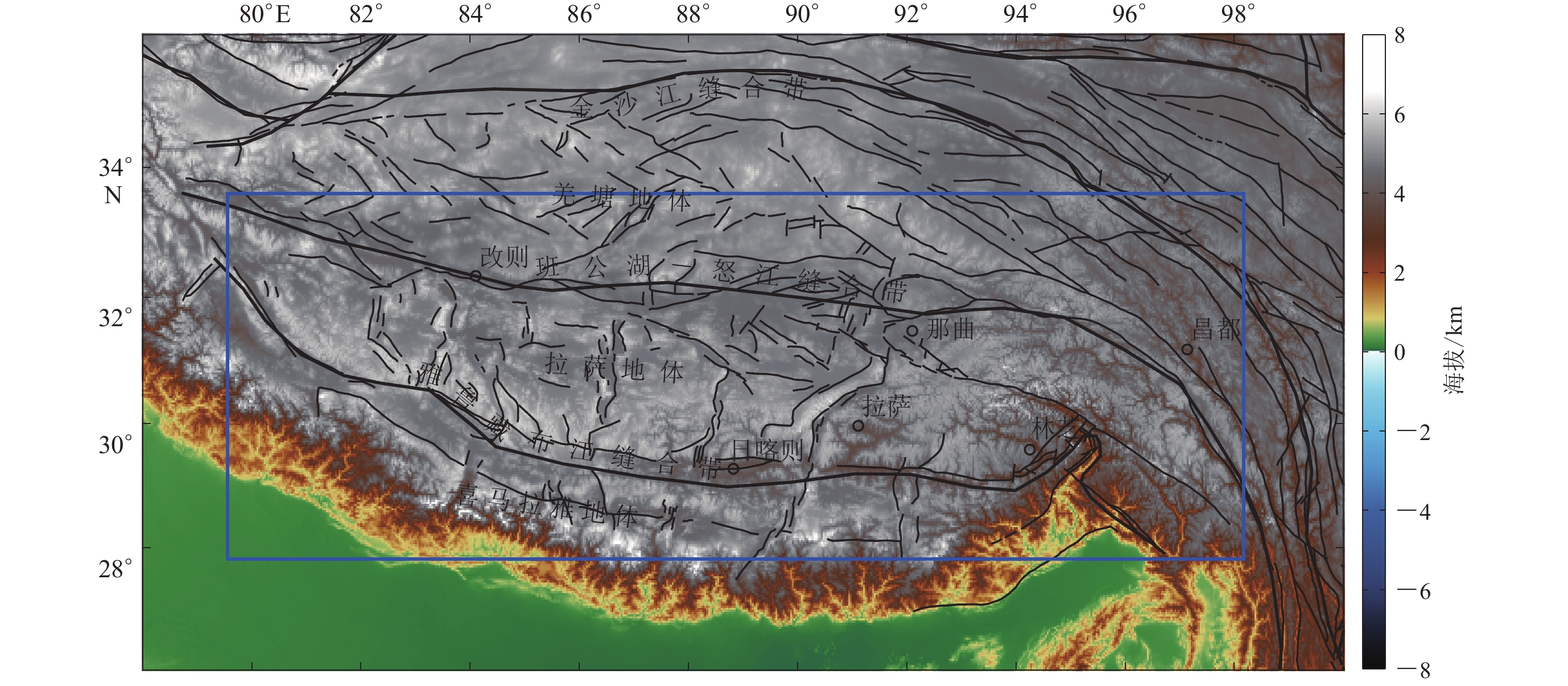
 下载:
下载:





